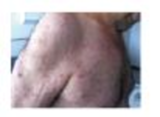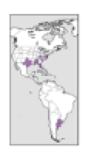
Concept explainers
A New Cause of Spots

Fifty-two-year-old David has a good life. After 30 years serving the country as an Army officer, he has retired to the Texas Gulf Coast-a region of large oaks, mild winter weather, and great outdoor spaces. It’s a great place to retire and enjoy hiking through the woods and meadows photographing wildlife. It would be nearly perfect if some of the wildlife didn't bite. Ubiquitous ants, pesky mosquitoes, and bloodsucking ticks seem to always be on the prowl.
It’s a tick that brings him to his doctor today. The thing had bit him on his left shoulder, resulting in a huge boil that swelled and drained pus, though the lesion doesn’t hurt at all. His primary care physician doesn’t appear to be too concerned and prescribes amoxicillin for the boil.
Three days later, David is back but feeling much worse. He has suddenly developed fever, headache, muscle pains, fatigue, and an alarming rash over most of his body. The physician now suspects Rocky Mountain spotted fever (RMSF), though it’s relatively rare in Texas, and orders a laboratory test using anti-Rickettsia rickettsii antibodies. The test comes back negative; David is not infected with R. rickettsii. He does not have RMSF. The doctor takes a skin sample from the infected area and prescribes 100 mg of doxycycline twice daily for two weeks.

The rash resolves in a week, and further polymerase chain reaction (PCR) testing on bacteria found in the sample of skin reveals R. parkeri. In the United States, the Gulf Coast tick, Amblyomma maculatum, is the vector for this bacterium that was long thought to be harmless to humans. David is one of the first of several dozen patients to tangle with this pathogen that is emerging as a threat in the southeast United States and in Argentina.
- 1. Why didn’t the antibody test show infection?
- 2. What is PCR testing?
- 3. In a
Gram-stained sample of David's skin, what color would the rickettsias be?
Want to see the full answer?
Check out a sample textbook solution
Chapter 19 Solutions
Microbiology with Diseases by Body System (5th Edition)
- What is the concept "calories consumed must equal calories burned" in regrads to nutrition?arrow_forwardYou intend to insert patched dominant negative DNA into the left half of the neural tube of a chick. 1) Which side of the neural tube would you put the positive electrode to ensure that the DNA ends up on the left side? 2) What would be the internal (within the embryo) control for this experiment? 3) How can you be sure that the electroporation method itself is not impacting the embryo? 4) What would you do to ensure that the electroporation is working? How can you tell?arrow_forwardDescribe a method to document the diffusion path and gradient of Sonic Hedgehog through the chicken embryo. If modifying the protein, what is one thing you have to consider in regards to maintaining the protein’s function?arrow_forward
- The following table is from Kumar et. al. Highly Selective Dopamine D3 Receptor (DR) Antagonists and Partial Agonists Based on Eticlopride and the D3R Crystal Structure: New Leads for Opioid Dependence Treatment. J. Med Chem 2016.arrow_forwardThe following figure is from Caterina et al. The capsaicin receptor: a heat activated ion channel in the pain pathway. Nature, 1997. Black boxes indicate capsaicin, white circles indicate resinferatoxin. You are a chef in a fancy new science-themed restaurant. You have a recipe that calls for 1 teaspoon of resinferatoxin, but you feel uncomfortable serving foods with "toxins" in them. How much capsaicin could you substitute instead?arrow_forwardWhat protein is necessary for packaging acetylcholine into synaptic vesicles?arrow_forward
- 1. Match each vocabulary term to its best descriptor A. affinity B. efficacy C. inert D. mimic E. how drugs move through body F. how drugs bind Kd Bmax Agonist Antagonist Pharmacokinetics Pharmacodynamicsarrow_forward50 mg dose of a drug is given orally to a patient. The bioavailability of the drug is 0.2. What is the volume of distribution of the drug if the plasma concentration is 1 mg/L? Be sure to provide units.arrow_forwardDetermine Kd and Bmax from the following Scatchard plot. Make sure to include units.arrow_forward
- Choose a catecholamine neurotransmitter and describe/draw the components of the synapse important for its signaling including synthesis, packaging into vesicles, receptors, transporters/degradative enzymes. Describe 2 drugs that can act on this system.arrow_forwardThe following figure is from Caterina et al. The capsaicin receptor: a heat activated ion channel in the pain pathway. Nature, 1997. Black boxes indicate capsaicin, white circles indicate resinferatoxin. a) Which has a higher potency? b) Which is has a higher efficacy? c) What is the approximate Kd of capsaicin in uM? (you can round to the nearest power of 10)arrow_forwardWhat is the rate-limiting-step for serotonin synthesis?arrow_forward
 Medical Terminology for Health Professions, Spira...Health & NutritionISBN:9781305634350Author:Ann Ehrlich, Carol L. Schroeder, Laura Ehrlich, Katrina A. SchroederPublisher:Cengage Learning
Medical Terminology for Health Professions, Spira...Health & NutritionISBN:9781305634350Author:Ann Ehrlich, Carol L. Schroeder, Laura Ehrlich, Katrina A. SchroederPublisher:Cengage Learning- Understanding Health Insurance: A Guide to Billin...Health & NutritionISBN:9781337679480Author:GREENPublisher:Cengage
 Comprehensive Medical Assisting: Administrative a...NursingISBN:9781305964792Author:Wilburta Q. Lindh, Carol D. Tamparo, Barbara M. Dahl, Julie Morris, Cindy CorreaPublisher:Cengage LearningEssentials Health Info Management Principles/Prac...Health & NutritionISBN:9780357191651Author:BowiePublisher:Cengage
Comprehensive Medical Assisting: Administrative a...NursingISBN:9781305964792Author:Wilburta Q. Lindh, Carol D. Tamparo, Barbara M. Dahl, Julie Morris, Cindy CorreaPublisher:Cengage LearningEssentials Health Info Management Principles/Prac...Health & NutritionISBN:9780357191651Author:BowiePublisher:Cengage





